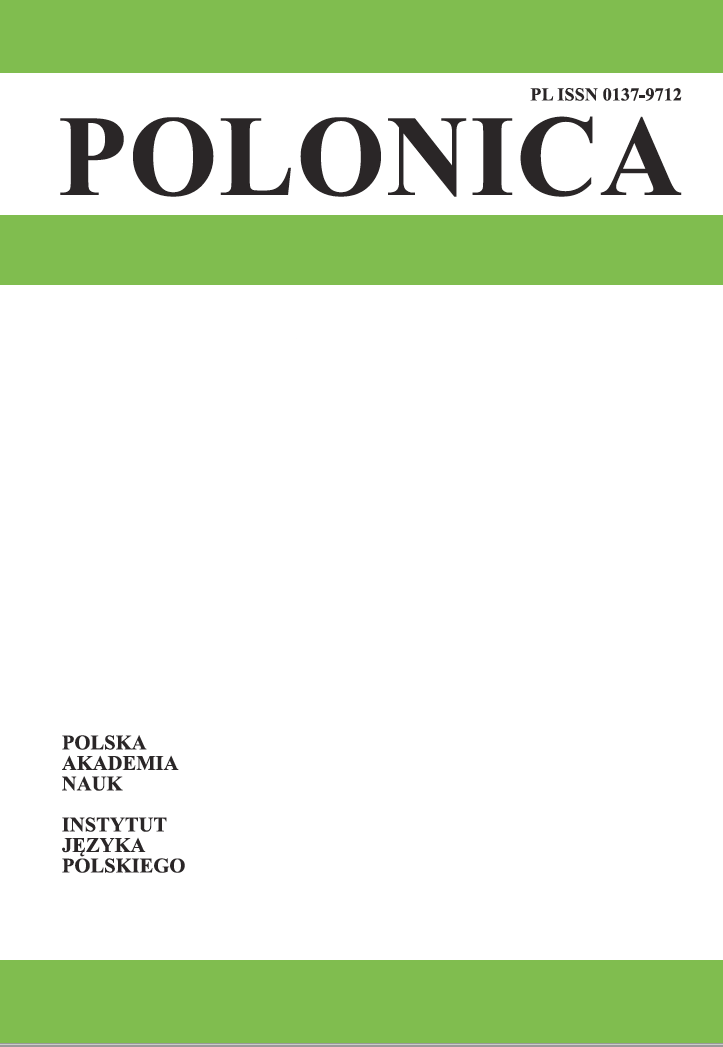Abstrakt
This article addresses the classical theory of linguistic picture of the world which was introduced by W. Humboldt. According to this approach, every language, characteristic for a certain speaking (speech?) community, has a specific way in which the world is perceived (Weltansicht). Polish linguists working on the so-called Linguistic Picture of the Wold framework departed from this initial notion, what was criticized by a number of scholars, who warn about inprecise interpretation of the Humboldtian term. The article aims at showing that it is possible to systematically explore the Linguistic Picture of the World (in the classical meaning) via contrastive examination of the structure of language; this should be extended with a cognitive interpretation of the observed phenomena. The text is illustrated by examples taken from Polish and German. Such a method – combining structuralism and cognitivism - proved to be fruitful some time ago: two linguists (from Poland and Germany), working separately, came to same conclusions regarding Polish verbal aspect. Their work opened a new perspective on translation equivalents of the Slavic aspect to the so-called aspectless languages. Subsequently, the possibility of systematic analyses (in the classical sense) is underlined. Among such methods a contrastive comparison of language structures, enriched by the cognitive interpretation, could be recommended. Different samples, taken from Polish and German language, serve as examples in this text. Similar method, based on combining these structural and cognitive methodologies, has been successfully used in the past. Simultaneously. The results of their work offered a completely new prospects for indicating translational equivalents of the Slavic aspectual verbs in the non-aspectual languages.
Bibliografia
Arutjunowa N.D., 1981, Metafora językowa (Składnia i leksyka), tłum. J. Faryno, Teksty 6, s. 158–170; 1, s. 159–172.
Bartmiński J., 2006, Językowe podstawy obrazu świata, Lublin.
— 1998, Zaproszenie do językoznawstwa, Kraków.
— (red.), 1999, Językowy obraz świata, Lublin.
Brożyna M., 2010, Językowy w języku, tekstowy w tekście, [w:] Etnolingwistyka a leksykografi a, Opole, s. 103–112.
Cockiewicz W., 2011, Metaforyka Leśmiana, Kraków.
— 2007, Na peryferiach aspektu, LingVaria 2, s. 9–25.
— 2005, Der „weibliche“ Tod und ritterliche Tradition der Polen, [w:] Studia Slavica Waltheri Kroll,
Göttingen, s. 31–35.
— 1995, Ein unzuverlässiger Freund — das Wörterbuch, [w:] Studia Slavica Joanni Schulze…, Göttingen, s. 42–49.
Cohen J., 1966, Structure du langage poétique, Paryż.
Grzegorczykowa R., 1997, Nowe spojrzenie na kategorię aspektu w perspektywie semantyki kognitywnej, [w:] Semantyczna struktura słownictwa i wypowiedzi, Warszawa, s. 25–38.
— 1995, Jak rozumieć kreatywny charakter języka? [w:] Kreowanie świata w tekstach, Lublin, s. 13–24.
— 1990, Pojęcie językowego obrazu świata, [w:] Językowy obraz świata, red. J. Bartmiński, Lublin,
s. 39–46.
Heinz A., 1978, Dzieje językoznawstwa w zarysie, Warszawa.
Humboldt W. von, 1936, Über die Verschiedenheit des menschlichen Sprachbaues und ihren Einfl uss auf die geistige Entwicklung des Menschengeschlechts, Berlin.
— 2002, O myśli i mowie. Wybór pism z teorii poznania, fi lozofi i dziejów i fi lozofi i języka, wybrała, przełożyła i poprzedziła słowem E.M. Kowalska, Warszawa.
Lakoff G., Johnson M., 1980/1988, Metaphors we live by, Chicago, wersja polska: Metafory w naszym życiu, tłum. T.P. Krzeszowski, Warszawa.
Lehmann V., 1993, Die russischen Aspekte als gestufte Kategorien (ein Beispiel für die Bedeutung der kognitiven
Linguistik in der slawistischen Sprachwissenschaft), Die Welt der Slaven, 38/2, s. 265–297.
Pawelec A., 2006, Metafora pojęciowa a tradycja, Kraków.
Przybylska R., 2010, Czy i jak wprowadzać kognitywizm do nauki języka polskiego jako obcego?, [w:] Polonistyka
bez granic, t. 2, Kraków, s. 31–40.
Ricoeur P., 1989, Język, tekst, interpretacja, tłum. P. Graff , K. Rosner, Warszawa.
Strekalova Z., 1968, Iz istorii polskogo glagolnogo vida, Moskwa.
Strub Ch., 1991, Kalkulierte Absurditäten: Versuch einer historisch refl ektierten sprachanalytischen Metaphorologie,
Freiburg München.
Tokarski R., 2004, Językowy obraz świata w metaforach potocznych, [w:] J. Bartmiński (red.), Językowy obraz świata, Lublin, s. 65−81.
— 1983, Uwagi o semantycznych mechanizmach zmian metaforycznych, [w:] Studia o metaforze II, red.
M. Głowiński, A. Okopień-Sławińska, Wrocław, s. 45−56
Vjatr K., 1978, Semantika i upotreblenije glagolov dviženija v sovremennom russkom i pol’skom jazykach,
Leningrad.
Włodarczyk H., 1980, Czasowniki ruchu a kategorie aspektu, Polonica VI, s. 49–56.
Żeromski S., 1978, Wierna rzeka, Wrocław.
Żuk G., 2010, Językowy obraz świata w polskiej lingwistyce przełomu wieków, [w:] Przeobrażenia w języku i komunikacji medialnej na przełomie XX i XXI wieku, Chełm, s. 239–257.
